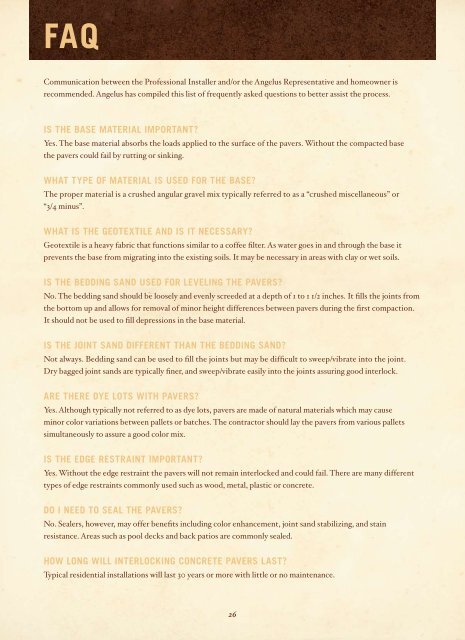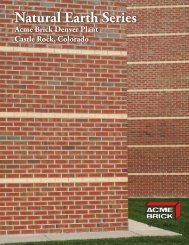THE PAVING STONE COLLECTION
THE PAVING STONE COLLECTION
THE PAVING STONE COLLECTION
Create successful ePaper yourself
Turn your PDF publications into a flip-book with our unique Google optimized e-Paper software.
faq<br />
Communication between the Professional Installer and/or the Angelus Representative and homeowner is<br />
recommended. Angelus has compiled this list of frequently asked questions to better assist the process.<br />
is the base material important?<br />
Yes. The base material absorbs the loads applied to the surface of the pavers. Without the compacted base<br />
the pavers could fail by rutting or sinking.<br />
what type of material is used for the base?<br />
The proper material is a crushed angular gravel mix typically referred to as a “crushed miscellaneous” or<br />
“3/4 minus”.<br />
what is the geotextile and is it necessary?<br />
Geotextile is a heavy fabric that functions similar to a coffee filter. As water goes in and through the base it<br />
prevents the base from migrating into the existing soils. It may be necessary in areas with clay or wet soils.<br />
is the bedding sand used for leveling the pavers?<br />
No. The bedding sand should be loosely and evenly screeded at a depth of 1 to 1 1/2 inches. It fills the joints from<br />
the bottom up and allows for removal of minor height differences between pavers during the first compaction.<br />
It should not be used to fill depressions in the base material.<br />
is the joint sand different than the bedding sand?<br />
Not always. Bedding sand can be used to fill the joints but may be difficult to sweep/vibrate into the joint.<br />
Dry bagged joint sands are typically finer, and sweep/vibrate easily into the joints assuring good interlock.<br />
are there dye lots with pavers?<br />
Yes. Although typically not referred to as dye lots, pavers are made of natural materials which may cause<br />
minor color variations between pallets or batches. The contractor should lay the pavers from various pallets<br />
simultaneously to assure a good color mix.<br />
is the edge restraint important?<br />
Yes. Without the edge restraint the pavers will not remain interlocked and could fail. There are many different<br />
types of edge restraints commonly used such as wood, metal, plastic or concrete.<br />
do i need to seal the pavers?<br />
No. Sealers, however, may offer benefits including color enhancement, joint sand stabilizing, and stain<br />
resistance. Areas such as pool decks and back patios are commonly sealed.<br />
how long will interlocking concrete pavers last?<br />
Typical residential installations will last 30 years or more with little or no maintenance.<br />
26







